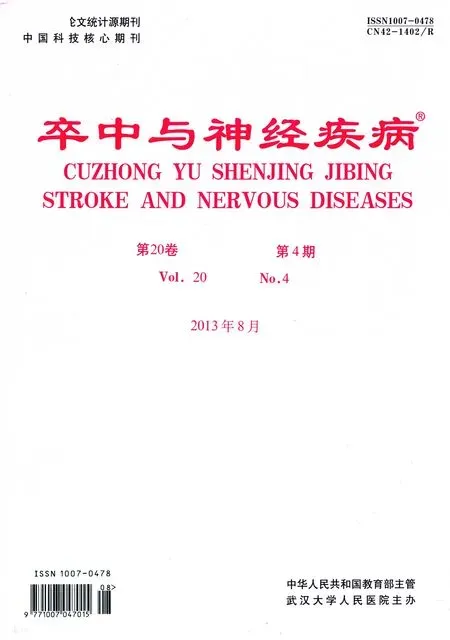神经肽Y及其受体与癫
2013-01-21徐晓雪徐承伟综述张朝东审校
徐晓雪 徐承伟(综述) 张朝东(审校)
神经肽Y(neuropeptide Y,NPY)即神经肽酪氨酸,是由36个氨基酸构成的一种活性多肽,属于胰多肽家族,广泛分布于中枢和外周神经系统中,是哺乳动物神经系统内含量最丰富的多肽之一,与焦虑、癫以及某些神经退行性疾病的发生发展存在密切联系[1]。近年来大量研究表明,癫发病的主要因素是中枢神经系统兴奋性与抑制性机制失衡从而导致神经元兴奋性异常增高,而NPY作为一种内源抑制性递质在调节神经元兴奋性的过程中起了很重要的作用,因而参与并影响癫的发病。本研究对近年来NPY在癫发病机制以及基因治疗等领域的研究进展做一综述。
1 NPY及其受体结构与分布
1.1 NPY
NPY是分子量约4.2 KD的多肽,广泛分布在哺乳动物中枢及周围神经系统、组织、器官和腺体中,结构具有高度序列保守性。NPY在中枢神经系统中主要分布在大脑皮层、海马、丘脑、下丘脑以及脑干等处,其中海马结构中的NPY浓度最高,能够合成经典的抑制性氨基酸γ-氨基丁酸(GABA)的中间神经元几乎都可以同时表达NPY,因此NPY是参与中枢神经系统兴奋性调控过程的重要物质[2]。
1.2 NPY受体
NPY受体属于G蛋白耦联受体家族成员,活化后通常与抑制性G蛋白(Gi)耦联而抑制腺苷酸环化酶活性,最终动员或抑制钙离子的释放;此外还可通过激活蛋白激酶C(protein kinase C,PKC)而启动下游多条相关信号通路[3]。在谷氨酸和GABA神经元轴突末端均发现了NPY受体,同时NPY/NPYR能够改变谷氨酸或者GABA的释放,这种调节是一种突触前调控。其作用机制可能与电压门控性钙离子通道有关[4]。
目前已经发现8种 NPY受体,分别命名为Y1-Y8[5]。其中Y1受体主要分布在海马齿状回分子层的颗粒细胞树突;Y2受体分布在海马基层区和CA1,CA3区,集中在Schaffer侧枝和苔藓纤维的突触末端;Y3受体表达在孤核神经元,能够调节内脏传出纤维的功能;Y4和Y5受体则分布在海马和大脑其它部位;Y6受体在人类中不表达,但是在大鼠海马区有表达,参与控制大鼠的摄食。最近所发现的Y7和Y8仅存在于两栖动物与硬骨鱼中。在哺乳动物中枢神经系统中主要表达的受体是Y1,Y2和Y5。
2 NPY及其受体在癫中的作用
NPY是一种突触前抑制剂,能够有效抑制谷氨酸引起的兴奋性突触传导。癫发作时NPY介导的机体内源性神经保护功能被启动以抵御癫造成的神经元损伤。虽然这种作用的具体机制尚未详细阐明,但是在体内或体外模型中均发现癫发作后NPY表达的异常升高,而且这种升高可以持续较长时间[6]。例如利用海人酸刺激大鼠癫发作,海马中间神经元表现出NPY表达的持续增加。类似的结果在匹鲁卡品大鼠致痫间模型中也可以观察到[7,8]。此外,注射外源性NPY能够增加Bcl-2等抗凋亡相关基因的表达,同时上调神经再生相关基因的表达,因此减少三甲氯化锡致痫间大鼠模型的神经元损伤[9]。但是最新的研究结果也显示,外源性NPY的注射位置也可以影响其抗癫作用的强弱[10]。由于NPY释放后通过与细胞膜上的NPY受体结合发挥其生物学功能。因此不同的NPY受体表达变化对癫发病的影响也可能有所差异。
2.1 Y1受体
人类的Y1受体广泛分布在海马,皮质以及丘脑和杏仁核中,对维持机体内部的能量环路平衡发挥重要作用。海马内Y1受体主要分布在颗粒细胞层突触后部位以及含有NPY的中间神经元中。当NPY与Y1受体结合后能够通过G蛋白作用促使钾离子内流以降低神经元兴奋性。“封闭”Y1受体的活性可促使细胞内NPY的释放“关闭”,从而加重癫的症状。这种理论已经通过红藻氨酸致痫模型和电休克致痫间模型得到验证[11]。间接证实了Y1受体在NPY的抗癫活动中发挥重要作用。在癫患者和动物模型中均发现癫发作后,颗粒细胞层中的Y1R表达急剧下降,伴随着Y1R阳性神经元的缺失与损伤。在无镁培养的癫离体模型中观察到外源性NPY通过作用Y1受体缓解了癫部分症状,提示NPY对于癫的治疗作用也可能是通过Y1受体实现的。但是最近也有学者认为NPY通过Y1受体的作用增加了海马神经元胞外谷氨酸的释放[12],说明了NPY与受体作用的复杂性以及不同实验模型之间的差异。
2.2 Y2受体
2.3 Y5受体
Y5受体是由两个剪切异构体编码的两个亚基组成的,这两个亚基分别由455个氨基酸和445个氨基酸构成。Nanobashviii等研究显示,Y5受体可以介导NPY对大鼠海马脑片CA3区发作间期自发性癫样放电的抑制作用[16]。Y5与Y2受体对于癫样放电的抑制作用是不同的。后者主要作用于癫大发作期,而Y5受体主要作用于发作间期放电。在Y5受体缺失的状态下NPY对于离体海马脑片的癫样放电不起作用。在急性癫发作后在体海马区Y5受体mRNA表达明显增加,提示Y5受体对于NPY抑制边缘性发作发挥关键作用。但是造模方式不同可能导致不同受体的差异表达变化不同。在Y5受体遗传性缺失的大鼠模型中能够观察到模型鼠对红藻氨酸诱发癫的敏感性显著提高,且对NPY的作用不敏感,从而提示了Y5受体是NPY抗痫间作用的主要受体之一[17]。在红藻氨酸致痫间大鼠模型中应用一种只对Y5受体有亲和力的NPY,发现模型鼠痉挛的症状减轻,表明NPY能通过Y5受体起着抗惊厥的作用。但是也有研究显示当NPY通过Y5受体作用时,在一定程度上能降低神经元的兴奋性,但其作用与通过Y2受体作用相比则显得较小,而且随着年龄增长而减少,并不足以阻止或减弱电刺激引起惊厥发作后的放电。
3 NPY与癫的基因治疗
4 展 望
1 Decressac M,Barker RA.Neuropeptide Y and its role in CNS disease and repair.Exp Neurol,2012 238(2):265-272.
2 Decressac M,Barker RA.Neuropeptide Y and its role in CNS disease and repair.Exp Neurol,2012 238(2):265-272.
3 Ana PS,Joana L,Sara X,et al Protein kinase C activity blocks neuropeptide Y-mediated inhibition of glutamate release and contributes to excitability of the hippocampus in status epileptics.FASEB J,2007 21(3):671-681.
4 van den Pol AN.Neuropeptide transmission in brain circuits.Neuron,2012 76(1):98-115.
5 Walther C,Mörl K,Beck-Sickinger AG.Neuropeptide Y receptors:ligand binding and trafficking suggest novel approaches in drug development.J Pept Sci,2011,17(4):233-246.
6 Cardoso A,Freitas-da-Costa P,Carvalho LS,et al Seizure-induced changes in neuropeptide Y-containing cortical neurons:Potential role for seizure threshold and epileptogenesis.Epilepsy Behav,2010,19(4):559-567.
7 Drexel M,Kirchmair E,Wieselthaler-Hölzl A,et al Somatostatin and neuropeptide Y neurons undergo different plasticity in parahippocampal regions in kainic acid-inducedepilepsy.J Neuropathol Exp Neurol,2012,71(4):312-329.
8 Cardoso A,Freitas-da-Costa P,Carvalho LS,et al.Seizure-inducedchanges in neuropeptide Y-containing cortical neurons:Potential role for Seizure threshold andepileptogenesis Epilepsy Behav,2010,19(4):559-567.
9 Corvino V,Marchese E,Giannetti S,et al The neuroprotective and neurogenic effects of neuropeptide Y administration in an animal model of hippocampal neurodegeneration and temporal lobe epilepsy induced by trimethyltin.J Neurochem,2012,122:415-426.
10 van Raay L,Jovanovska V,Morris MJ,et al Focal administration of neuropeptide Y into the S2 somatosensory cortex maximally suppresses absence seizures in a genetic rat model.Epilepsia,2012,53(3):477-484.
11 ParedesM.F.,Greenwood J.,Baraban,.C.Neuropeptide Y modulates a G protein-coupled inwardly rectifying potassium current in the mouse hippocampus.Neurosci Lett,2003,340(1):9-12.
12 Meurs A,Portelli J,Clinckers R,et al.Neuropeptide Y increases in vivo hippocampal extracellular glutamate levels through Y1 receptor activation.Neurosci Lett,2012,510(2):143-147.
13 Stani?D,Mulder J,Watanabe M,et al Characterization of NPY Y2 receptor protein expression in the mouse brain.II:Coexistence with NPY,the Y1 receptor,and other neurotransmitterrelated molecules.J Comp Neurol,2011 519(7):1219-1257.
14 Woldbye DP,Nanobashvili A,Sorensen AT,et al.Differential suppression of seizures via Y2 and Y5 neuropeptide Y receptors.Neurobiol Dis,2005,10(3):760-772.
15 Morris MJ,Gannan E,Stroud LM,et al Neuropeptide Y suppresses absence seizures in a genetic rat model primarily through effects on Y receptors.Eur J Neurosci,2007,25(4):1136-1143.
16 Nanobashvili A,Woldbye D,Husum H,et al Neuropeptide Y5 receptors suppress in vitro spontaneous epileptiform bursting in the rat hippoeampus.NeuroReport,2004,15(2):339-343.
17 Nairismagi J,Gröhn OH,Kettunen MI,et al Progression of brain damage after status epilepticus and its association with epileptogenesis:aquantitative MRI study lnarat model of temporal lobe Epilepsy.Epilepsia,2004,45(9):1024-1034.
18 Gøtzsche CR,Nikitidou L,Sørensen AT,et al Combined gene overexpression of neuropeptide Y and its receptor Y5 in the hippocampus suppresses seizures.Neurobiol Dis,2012,45(1):288-296.
19 Jimenez-Mateos EM,Mouri G,Conroy RM,et al Epileptic tolerance is associated with enduring neuroprotection and uncoupling of the relationship between CA3 damage,neuropeptide Y rearrangement and spontaneous seizures following intra-amygdala kainic acid-induced status epilepticus in mice.Neuroscience,2010,171(2):556-565.
20 Noe FM.,Sorensen AT.,Kokaia M,et al Gene therapy of focal-onset epilepsy by adeno-associated virus vector-mediated overexpression of neuropeptide Y.Epilepsia,2010,51(5):96.
21 Noe F,Vaghi V.,Balducci C,et al Anticonvulsant effects and behavioural outcomes of rAAV serotype 1 vector-mediated neuropeptide Y overexpression in rat hippocampus.Gene Ther,2010,17(5):643-652.
22 McCown TJ.The future of epilepsy treatment:focus on adenoassociated virus vector gene therapy.Drug News Perspect,2010,23(5):281-286.
23 Lin EJ,Lin S,Aljanova A,et al Adult-onset hippocampal-specific neuropeptide Y overexpression confers mild anxiolytic effect in mice.Eur Neuropsychopharmacol,2010,20(3):164-175.
24 Woldbye DP,Angehagen M,Gøtzsche CR,et al.Adeno-associated viral vector-induced overexpression of neuropeptide Y Y2 receptors in the hippocampus suppresses seizures.Brain,2010,133(9):2778-2788.
25 NoéF,Frasca A,Balducci C,et al.Neuropeptide Y overexpression using recombinant adeno-associated viralvectors.Neurotherapeutics,2009,6(2):300-306.
